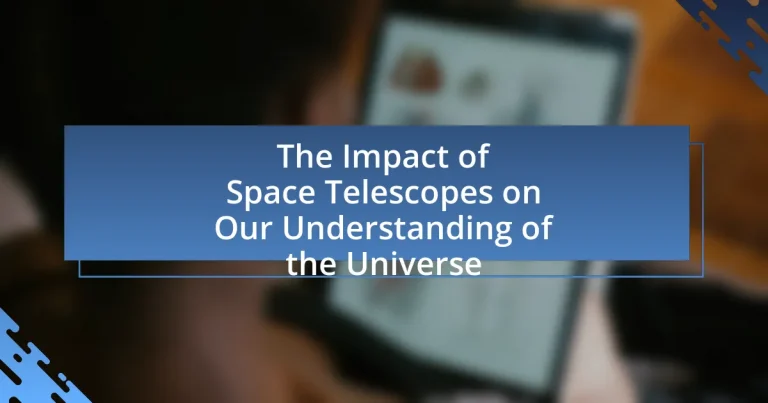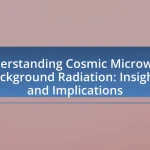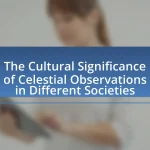Space telescopes are astronomical instruments positioned beyond Earth’s atmosphere, designed to observe celestial objects and phenomena with minimal atmospheric interference. This article explores the significance of space telescopes, such as the Hubble Space Telescope and the James Webb Space Telescope, in advancing our understanding of the universe, including their advantages over ground-based telescopes, the challenges they face, and their contributions to key discoveries in astrophysics and cosmology. It also discusses future developments and missions that promise to enhance observational capabilities and deepen our knowledge of cosmic phenomena, including the search for extraterrestrial life and the understanding of dark matter and dark energy.
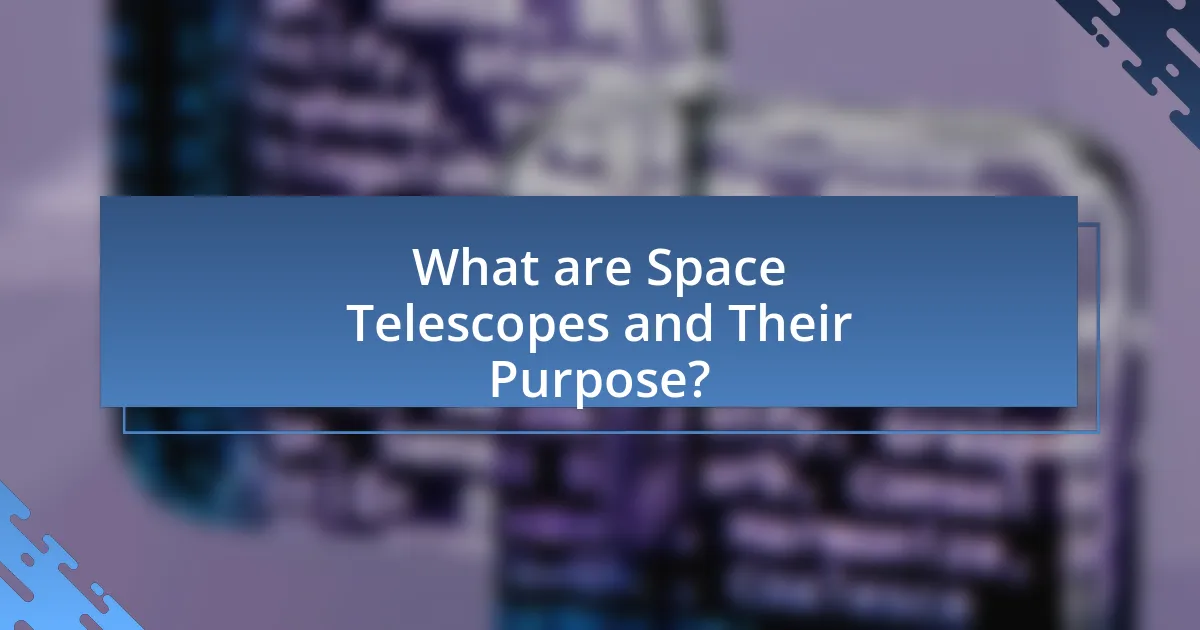
What are Space Telescopes and Their Purpose?
Space telescopes are astronomical instruments located outside Earth’s atmosphere that observe celestial objects and phenomena. Their primary purpose is to capture high-resolution images and data across various wavelengths, such as visible, infrared, and ultraviolet light, without the interference of atmospheric distortion. For example, the Hubble Space Telescope has provided invaluable insights into the age of the universe, the existence of exoplanets, and the behavior of distant galaxies, significantly enhancing our understanding of cosmic evolution.
How do Space Telescopes differ from Ground-Based Telescopes?
Space telescopes differ from ground-based telescopes primarily in their location, which allows them to avoid atmospheric interference. Space telescopes operate above Earth’s atmosphere, enabling them to capture clearer images and detect a broader range of wavelengths, including ultraviolet and infrared light, which are absorbed by the atmosphere. For example, the Hubble Space Telescope, launched in 1990, has provided high-resolution images and data that have significantly advanced our understanding of cosmic phenomena, such as the expansion of the universe and the formation of galaxies. In contrast, ground-based telescopes are limited by atmospheric turbulence and light pollution, which can distort observations and restrict the wavelengths they can effectively observe.
What advantages do Space Telescopes have over Ground-Based Telescopes?
Space telescopes have the advantage of operating above Earth’s atmosphere, which allows them to capture clearer and more detailed images of celestial objects. Ground-based telescopes face atmospheric interference, such as turbulence and light pollution, which can distort observations. For instance, the Hubble Space Telescope, launched in 1990, has provided images with a resolution significantly higher than those from ground-based telescopes, enabling discoveries such as the precise measurement of the expansion rate of the universe. This clarity enhances our understanding of cosmic phenomena, leading to breakthroughs in astrophysics and cosmology.
What challenges do Space Telescopes face in their operations?
Space telescopes face several operational challenges, including the harsh environment of space, limited maintenance opportunities, and the need for precise alignment and calibration. The extreme temperatures and radiation in space can damage sensitive instruments, making it essential for telescopes to be designed with robust shielding and thermal control systems. Additionally, once launched, these telescopes cannot be easily repaired or upgraded, as demonstrated by the Hubble Space Telescope’s servicing missions, which were critical for its longevity. Furthermore, maintaining precise alignment is crucial for capturing clear images, as even minor misalignments can lead to significant data loss. These challenges highlight the complexities involved in the operation of space telescopes and their reliance on advanced engineering and technology.
Why are Space Telescopes important for astronomical research?
Space telescopes are crucial for astronomical research because they operate above Earth’s atmosphere, allowing for clearer and more detailed observations of celestial objects. This atmospheric absence eliminates distortion and absorption of light, enabling telescopes like the Hubble Space Telescope to capture high-resolution images across various wavelengths, including ultraviolet and infrared. For instance, Hubble has provided insights into the expansion rate of the universe and the presence of exoplanets, significantly advancing our understanding of cosmic phenomena.
How do Space Telescopes contribute to our understanding of cosmic phenomena?
Space telescopes enhance our understanding of cosmic phenomena by providing unobstructed views of the universe beyond Earth’s atmosphere. This capability allows them to capture high-resolution images and data across various wavelengths, including ultraviolet, visible, and infrared light. For instance, the Hubble Space Telescope has revealed the existence of exoplanets and contributed to the discovery of dark energy, fundamentally altering our comprehension of the universe’s expansion. Additionally, space telescopes like the James Webb Space Telescope are designed to observe the formation of stars and galaxies, offering insights into the early universe and the processes that govern cosmic evolution. These observations are critical for advancing astrophysical theories and expanding our knowledge of the cosmos.
What role do Space Telescopes play in the search for extraterrestrial life?
Space telescopes play a crucial role in the search for extraterrestrial life by enabling the observation of distant exoplanets and their atmospheres. These telescopes, such as the Hubble Space Telescope and the upcoming James Webb Space Telescope, utilize advanced imaging and spectroscopy techniques to analyze the chemical compositions of planetary atmospheres. For instance, Hubble has detected water vapor in the atmospheres of exoplanets like WASP-121b, providing insights into potential habitability. Additionally, space telescopes can identify biosignatures, such as oxygen and methane, which are indicators of biological processes. The ability to gather data from beyond Earth’s atmosphere allows for clearer and more detailed observations, significantly enhancing our understanding of where life might exist in the universe.
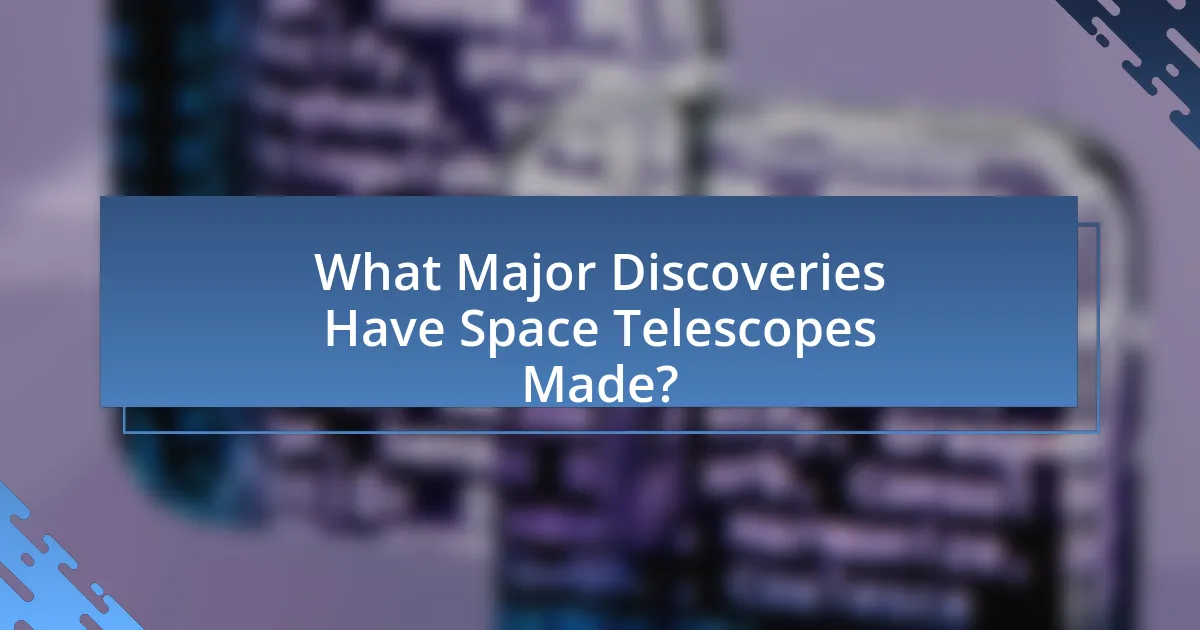
What Major Discoveries Have Space Telescopes Made?
Space telescopes have made significant discoveries, including the detection of exoplanets, the observation of distant galaxies, and the measurement of cosmic background radiation. For instance, the Hubble Space Telescope has provided evidence of the accelerated expansion of the universe through observations of supernovae, leading to the conclusion that dark energy constitutes about 68% of the universe. Additionally, the Kepler Space Telescope has identified thousands of exoplanets, expanding our understanding of planetary systems beyond our own. These findings have fundamentally altered our comprehension of the universe’s structure and evolution.
What are some landmark observations made by Space Telescopes?
Space telescopes have made several landmark observations that significantly advanced our understanding of the universe. The Hubble Space Telescope, for instance, provided evidence for the accelerated expansion of the universe through its observations of distant supernovae, leading to the discovery of dark energy. Additionally, the Chandra X-ray Observatory has revealed the presence of black holes and the dynamics of galaxy clusters by detecting X-ray emissions from hot gas. The Kepler Space Telescope identified thousands of exoplanets, contributing to the understanding of planetary systems beyond our own. These observations are validated by extensive data collected and analyzed by astronomers, demonstrating the profound impact of space telescopes on cosmology and astrophysics.
How did the Hubble Space Telescope change our view of the universe?
The Hubble Space Telescope significantly changed our view of the universe by providing unprecedented clarity and detail in astronomical observations. Launched in 1990, Hubble has captured high-resolution images of distant galaxies, nebulae, and other celestial phenomena, revealing the universe’s structure and composition in ways that ground-based telescopes could not. For instance, Hubble’s observations have led to the discovery of the accelerating expansion of the universe, which was evidenced by its measurements of distant supernovae. This groundbreaking finding, published in 1998 by the Supernova Cosmology Project and the High-Z Supernova Search Team, fundamentally altered our understanding of cosmology and the role of dark energy. Hubble’s contributions have also enhanced our knowledge of the life cycles of stars and the formation of planetary systems, solidifying its role as a pivotal tool in modern astronomy.
What discoveries have been made by the James Webb Space Telescope?
The James Webb Space Telescope has made significant discoveries, including the detection of the most distant galaxy ever observed, named GLASS-z13, which formed just 300 million years after the Big Bang. This discovery provides insights into the early universe and galaxy formation. Additionally, the telescope has identified the chemical composition of exoplanet atmospheres, revealing the presence of water vapor in the atmosphere of the exoplanet WASP-96b. These findings enhance our understanding of the universe’s evolution and the potential for life beyond Earth.
How have Space Telescopes advanced our knowledge of the universe’s structure?
Space telescopes have significantly advanced our knowledge of the universe’s structure by providing unprecedented clarity and detail in astronomical observations. Instruments like the Hubble Space Telescope have enabled scientists to map the distribution of galaxies, revealing the large-scale structure of the universe, including the existence of dark matter and cosmic filaments. For instance, Hubble’s deep field images have shown thousands of galaxies in a small patch of sky, illustrating the vastness and complexity of the universe. Additionally, space telescopes have facilitated the study of cosmic background radiation, which supports the Big Bang theory and helps in understanding the universe’s expansion. These observations have been crucial in refining models of cosmic evolution and the formation of structures within the universe.
What insights have been gained about galaxy formation and evolution?
Insights into galaxy formation and evolution indicate that galaxies form through hierarchical merging, where smaller structures combine to create larger ones. Observations from space telescopes, such as the Hubble Space Telescope, have revealed that galaxies evolve over time, influenced by factors like dark matter, gas dynamics, and star formation rates. For instance, studies show that the rate of star formation in galaxies peaked around 10 billion years ago, suggesting a significant evolutionary phase during that period. Additionally, the discovery of massive early galaxies challenges previous models, indicating that galaxy formation is more complex than initially thought. These findings are supported by data from deep-field images and spectroscopic surveys, which provide evidence of the diverse morphologies and compositions of galaxies throughout cosmic history.
How have Space Telescopes contributed to our understanding of dark matter and dark energy?
Space telescopes have significantly advanced our understanding of dark matter and dark energy by providing precise measurements of cosmic phenomena. For instance, the Hubble Space Telescope has enabled astronomers to observe the distribution of galaxies and their clustering, which reveals the influence of dark matter on cosmic structure formation. Additionally, the observations of distant supernovae by the Hubble and other space telescopes have led to the discovery of the accelerated expansion of the universe, attributed to dark energy. These findings are supported by data from the Hubble Deep Field and the Supernova Cosmology Project, which have provided critical evidence for the existence and properties of dark matter and dark energy, respectively.
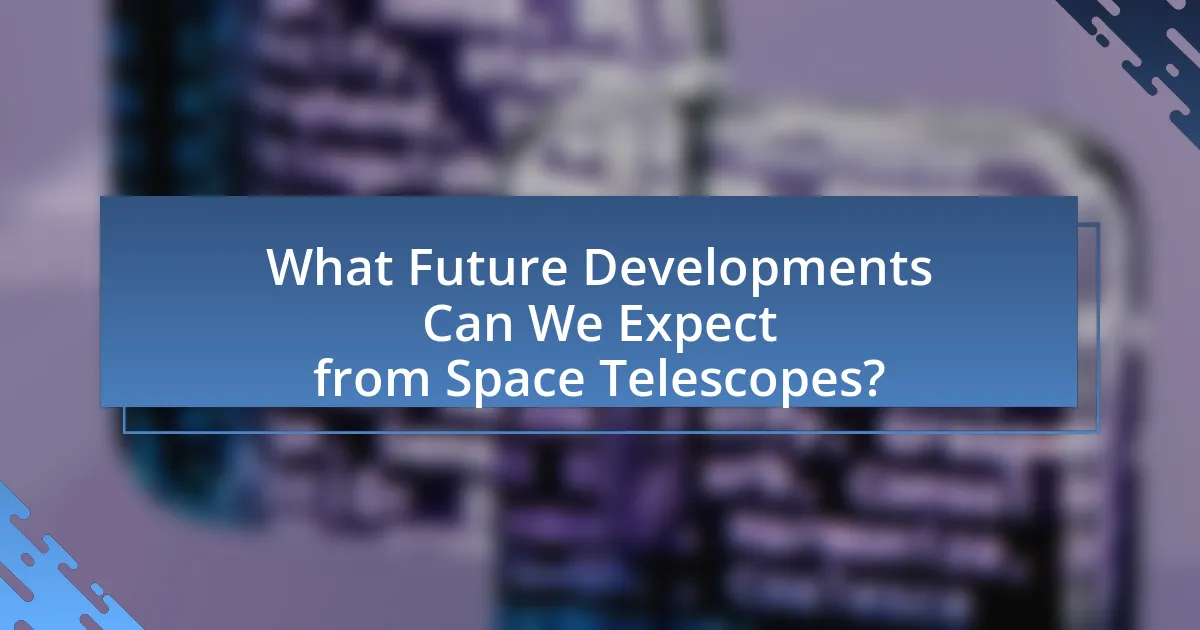
What Future Developments Can We Expect from Space Telescopes?
Future developments in space telescopes will include advancements in technology that enhance their observational capabilities, such as larger mirrors, improved sensors, and advanced data processing algorithms. For instance, the James Webb Space Telescope, launched in December 2021, features a 6.5-meter mirror that allows for unprecedented infrared observations, enabling scientists to study the formation of stars and galaxies in greater detail than ever before. Additionally, upcoming missions like the Roman Space Telescope, set to launch in the mid-2020s, will focus on wide-field imaging and survey capabilities, which will significantly contribute to our understanding of dark energy and exoplanets. These developments are expected to provide deeper insights into the universe’s structure and evolution, further enhancing our comprehension of cosmic phenomena.
What upcoming missions are planned for Space Telescopes?
The upcoming missions planned for space telescopes include the James Webb Space Telescope’s continued observations, the launch of the Roman Space Telescope in 2027, and the European Space Agency’s Euclid mission set for 2023. The James Webb Space Telescope, operational since December 2021, aims to explore the universe’s first galaxies and study exoplanets. The Roman Space Telescope will focus on dark energy and exoplanets, while the Euclid mission will investigate the geometry of the dark universe. These missions are designed to enhance our understanding of cosmic phenomena and the universe’s structure.
How will future Space Telescopes enhance our observational capabilities?
Future space telescopes will enhance our observational capabilities by providing higher resolution images and broader spectral coverage than current telescopes. For instance, the James Webb Space Telescope, launched in December 2021, operates in the infrared spectrum, allowing it to observe celestial objects that are too faint or distant for optical telescopes. Upcoming telescopes, such as the Roman Space Telescope, will further improve our ability to detect exoplanets and study dark energy through wide-field surveys, significantly increasing the amount of data available for analysis. These advancements will enable astronomers to explore the universe with unprecedented detail, leading to new discoveries about the formation of galaxies, stars, and planetary systems.
What technologies are being developed for next-generation Space Telescopes?
Next-generation space telescopes are being developed with advanced technologies such as segmented mirrors, adaptive optics, and infrared detectors. Segmented mirrors, like those planned for the James Webb Space Telescope, allow for larger apertures that enhance light-gathering capabilities, enabling the observation of fainter and more distant celestial objects. Adaptive optics technology compensates for atmospheric distortion, improving image clarity and resolution. Additionally, cutting-edge infrared detectors are being designed to capture a broader range of wavelengths, facilitating the study of cooler astronomical phenomena, such as exoplanets and distant galaxies. These technologies collectively aim to significantly enhance our understanding of the universe by providing deeper insights into its formation and evolution.
How will advancements in Space Telescopes impact our understanding of the universe?
Advancements in space telescopes will significantly enhance our understanding of the universe by enabling more detailed observations of celestial objects and phenomena. For instance, the James Webb Space Telescope, launched in December 2021, allows astronomers to observe the universe in infrared wavelengths, revealing previously hidden details about the formation of stars, galaxies, and planetary systems. This capability is crucial for studying the early universe, as it can detect light from the first galaxies formed after the Big Bang, providing insights into cosmic evolution. Additionally, advancements in adaptive optics and imaging technology improve resolution and sensitivity, allowing for the detection of exoplanets and the analysis of their atmospheres, which is essential for understanding the potential for life beyond Earth. These technological improvements collectively contribute to a more comprehensive and nuanced understanding of the universe’s structure, origins, and the fundamental laws governing it.
What potential discoveries could reshape our knowledge of astrophysics?
Potential discoveries that could reshape our knowledge of astrophysics include the detection of dark matter and dark energy, the identification of exoplanets with Earth-like conditions, and the observation of gravitational waves from cosmic events. The discovery of dark matter, which constitutes approximately 27% of the universe, could provide insights into the fundamental structure of the cosmos, while dark energy, making up about 68%, is crucial for understanding the universe’s accelerated expansion. The identification of exoplanets, particularly those in the habitable zone, could revolutionize our understanding of life beyond Earth. Furthermore, the observation of gravitational waves, first detected by LIGO in 2015, opens new avenues for studying phenomena such as black hole mergers and neutron star collisions, fundamentally altering our comprehension of the universe’s dynamics.
How might future Space Telescopes influence the search for habitable exoplanets?
Future space telescopes will significantly enhance the search for habitable exoplanets by providing advanced observational capabilities that allow for the detailed analysis of exoplanet atmospheres and compositions. These telescopes, such as the James Webb Space Telescope and upcoming missions like the Habitable Worlds Observatory, are designed to detect biosignatures and assess the habitability of planets in the habitable zone of their stars. For instance, the James Webb Space Telescope can analyze the light spectra of exoplanets, identifying key molecules like water vapor, carbon dioxide, and methane, which are indicators of potential life. This capability is crucial, as it enables scientists to prioritize which exoplanets warrant further study based on their atmospheric conditions.
What practical tips can enhance our engagement with Space Telescope discoveries?
To enhance engagement with Space Telescope discoveries, individuals should actively participate in online forums and social media discussions focused on astronomy. Engaging with communities such as NASA’s Astronomy Picture of the Day or the Hubble Space Telescope’s social media accounts allows for real-time updates and insights. Additionally, attending public lectures or webinars hosted by astronomers can deepen understanding and appreciation of the discoveries. Research shows that interactive learning experiences, such as planetarium visits or virtual reality simulations of space, significantly increase interest and retention of astronomical knowledge. By utilizing these resources, individuals can foster a more profound connection with the discoveries made by Space Telescopes.
How can the public access and interpret data from Space Telescopes?
The public can access and interpret data from space telescopes through various online platforms and databases provided by space agencies. NASA’s Hubble Space Telescope website, for example, offers a dedicated section for public access to images and data, allowing users to explore and download scientific data. Additionally, the European Space Agency provides access to data from the Gaia mission, which can be analyzed through their dedicated archive. These platforms often include user-friendly tools and tutorials that help individuals understand the data, such as visualizations and educational resources. The availability of such resources enables the public to engage with astronomical data and enhances their understanding of the universe.
What resources are available for learning more about Space Telescopes and their findings?
Resources for learning about space telescopes and their findings include official websites of major space agencies such as NASA and ESA, which provide extensive information on missions, discoveries, and educational materials. For instance, NASA’s Hubble Space Telescope site offers access to images, data, and research articles that detail its contributions to astronomy. Additionally, academic journals like “The Astrophysical Journal” publish peer-reviewed research on findings from various space telescopes, ensuring access to credible scientific information. Online platforms like Coursera and edX offer courses on astronomy and space science that cover the role of space telescopes in understanding the universe.
